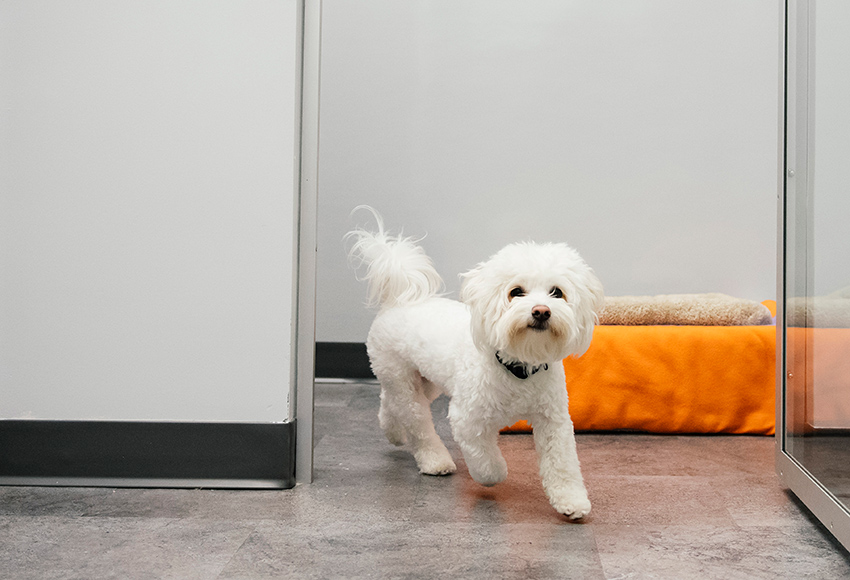Fleas and Ticks
What are Fleas and Tick’s?
Ticks are gross—they are, essentially, blood-sucking parasites that feed off warm-blooded animals and they have a particular preference for dogs. Ticks are parasitic arachnids; this means they have eight legs and that they live on the blood and tissue of their host animal. They’re found in wooded, grassy areas and hang out on the edges of leaves, twigs, and grasses, so that they can drop on a potential host as it passes nearby. They do not jump or fly.
Once a tick lands on its potential host, it will try to travel to a warm, dark crevice to attach and feed—think armpits, ears, and belly folds. A tick attaches to its host via its mandibles (jaw) and inserts a feeding tube directly into the superficial capillaries of the host organism. Because they attach with their head and jaw, they tend to burrow slightly beneath the skin. This is why it is vitally important to make sure the tick head is removed with the tick body to prevent additional infection and discomfort.
Flea’s are equally as gross. They are a parasitic six-legged insect that feeds on the blood of their hosts. Their bodies are wingless but made for jumping and their compressed shape means that it’s easy for them to run through the hair of your dog. Flea’s thrive in warm, humid condition and a female flea requires a “blood meal” in order to lay her eggs. Their droppings, the reddish-brown “flea dirt” that you see on your pet, is actually what larvae need to feed on to live.
How Do I Know if my Pet Has Fleas or Ticks?
Checking your Dog for Ticks
To get started checking your dog for ticks, you may want to start by petting your dog to get them comfortable and relaxed. This way, they will release their muscles and you can better manipulate their limbs to check in sensitive places, like armpits, where ticks love to hang out.
- Put on a pair of latex gloves. Humans are susceptible to infection from tick diseases, and taking this precaution helps protect you from illness.
- Feel for small bumps and ridges all over your pet’s coat. Typically, you will first recognize a tick through touch. They are small, round, and smooth and most species have a hard exterior.
- Examine the crevices between skin folds, especially under the arms and legs of your pet. Ticks love a warm, dark place to hide out and are likely to be burrowed into these places on your pet’s body. Also, don’t forget the areas in and around their ears!
- Pull back the fur around a suspicious area to inspect. Depending on the length and thickness of your pet’s fur, you may have to go to more trouble to part the hair, so you can see your pet’s skin underneath.
Be thorough with your inspection. This may mean that you have to get out a fine-tooth comb and go over every inch of your pet’s wiry and thick coat. It may be a bit of a chore, but it is certainly worth it—the longer a tick stays on a dog or cat only increases the risk for disease transmission and infection.
Checking Your Dog for Fleas
In severe infestations, it’s easy to spot fleas jumping and moving on and off your dog’s body. In less obvious situations, you may notice that your dog is restless and is scratching, licking or chewing more than normal on certain areas of her body. Shaking the head often and scratching at the ears is another indication of a possible flea infestation in your dog. In order to see actual fleas on your dog, you may have to look fast. Fleas can jump very fast and very high, and even at their adult size they are very small (1/16-1/8 in.). They are flat-bodied and dark brown, almost black, in color. The more blood they ingest the lighter in color they may appear.
To inspect your dog, turn her onto her back and check the areas that allow fleas to hide best. The armpits and groin are two areas that tend to be warm and protected, making them preferred spots for large flea populations. Check the ears carefully for signs of scratching, redness, blood, or dirt. These can all be signs of fleas. The skin on the belly, groin, or base of the tail may appear red and bumpy, especially if your dog is doing a lot of scratching. Hair loss may occur in certain areas that are being scratched excessively, and there may be black spots on the skin along with scabbing. Get a flea comb (a specially made comb with closely set teeth) and run it through the hair on your dog’s back and legs. The comb’s teeth are designed to catch and pull fleas out from under the hair coat where they are hiding. Make sure you get close to the skin when running the comb through the hair, so you have a greater chance of getting to where the fleas are hiding out. Have a bowl of soapy water on hand to throw any live fleas into as you comb.
One trick that may help you if the fleas are hard to see is to place a white piece of paper or paper towel on the floor next to or beneath your dog while coming through her hair. Flea dirt (flea feces) will fall off of the dog’s skin and land on the paper. One way to tell the difference between regular dirt and flea “dirt” is to wet any black specks that fall off the dog onto the white paper towel (using regular water sprinkled on the specks). If they turn a dark reddish-brown color, you are seeing the digested blood that the flea has passed through its body and excreted.
Removing Fleas and Ticks
Ticks
When examining your pet, remember—depending on its species and life stage, a tick can be as small as a pencil point, or as large as a bean (if it’s engorged). If you find a tick on the coat that hasn’t attached yet, just brush or pick it off and dispose of it. If you find a tick attached to your pet’s skin, don’t panic—it doesn’t necessarily mean disease. However, it’s important to remove the tick properly. If you have never removed a tick, please visit your veterinarian to learn how to do this correctly. After tick removal, you may want to keep it sealed tightly in a jar, so you can show it to your veterinarian, who knows which potential disease the particular tick species can transmit.
Fleas
Most flea problems aren’t usually concentrated at just one particular location of your house. If you have a dog in your home, it is more than likely that they’ve spread the fleas everywhere they’ve gone to. A dog or cat is basically a 24/7 operating shuttle for fleas to hop on and off wherever they want to. It is very important to get rid of the fleas and eggs in your whole house and on your dog’s/cats simultaneously.
There are many oral and topical flea/tick treatments available for dogs. It is best to speak with your veterinarian to choose which product would be best suited for your dog and lifestyle.






